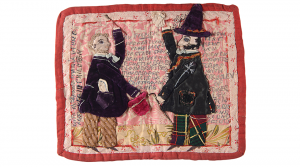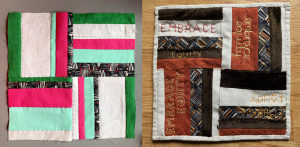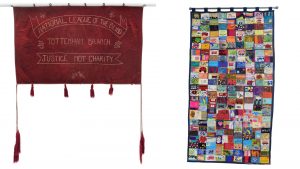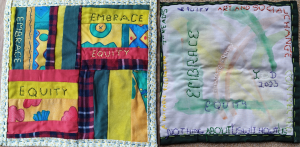Gill Crawshaw is a curator, based in Leeds, who draws on her experience of disability activism to organise art exhibitions and events which highlight issues affecting disabled people. She is interested in the intersection of disabled people’s lives with textile heritage in the north of England, as well as with contemporary textile arts.
In March 2023, Gill took part in People’s History Museum’s (PHM) The Fabric of Protest workshop. She reflects on how disabled people have used textiles as a powerful tool of communication and explores some of the objects on show in PHM’s current exhibition about disabled people’s activism, Nothing About Us Without Us.
Amongst an array of objects in Nothing About Us Without Us, the fantastic exhibition documenting disabled people’s fight for equality and respect in the UK, there is a small embroidered panel. It is easy to miss amongst the brightly coloured banners, placards, photos and artwork that fill the gallery. But it is a significant and precious item. It is a piece of needlework of two well-dressed men, appliquéd using scraps of fabric and embellished with closely-packed text. It was created by Lorina Bulwer around the end of the 19th century, along with her remarkable series of embroidered scrolls.

Bulwer was a needleworker whose brother put her in an asylum in Great Yarmouth when she was 55. It was here that she created her embroideries expressing her anger at her situation. The scrolls are neatly and densely stitched, and read as if they are a stream of consciousness. What is fascinating about them is how clearly Bulwer’s voice comes through.
Nothing About Us Without Us emphasises the importance of collective action by disabled people. Although Bulwer was telling her story in isolation, her work reminds us of the long history of segregation and institutionalisation that disabled people have fought against. And she is part of an ongoing tradition amongst disabled people to use textiles to express messages of protest and resistance.

Using textiles in this way has particular resonance for disabled people. Starting in asylums and workhouses, and continuing in occupational therapy in hospitals and day centres, textiles and needlework have long been an activity aimed to keep disabled people busy and quiet. But disabled people have subverted this! Rather than being therapeutic, they have found that textiles can be used as a powerful and accessible form of communication.
This is evident in Nothing About Us Without Us, with its sea of banners from the disabled people’s movement. So many campaigns and struggles are represented in fabric, using strong graphic images and slogans, including the title of the exhibition.

‘Rights Not Charity’ is another key slogan of the disabled people’s movement, originating from the demands of the National League of the Blind. This organisation of disabled people was formed as a trade union in 1894 and fought for employment and rights in the face of exploitation, not just in the workplace but also by charities. In 1920 they marched on London from Leeds, Manchester and Newport, carrying banners with their slogan ‘Justice Not Charity’. They gained support for their cause, and their march led to the passing of the Blind Person’s Act the same year. One of the League’s banners, with their slogan embroidered on it, has its rightful place in Nothing About Us Without Us.
There is another important textile object in the exhibition: the quilt made by supporters of the campaign that sought Justice for LB, “Laughing Boy” Connor Sparrowhawk. Connor died in 2013, aged 18, while a patient in a specialist NHS unit for people with learning disabilities in Oxford. An independent inquiry found that his death had been ‘preventable’ and the inquest concluded that neglect was a contributory factor in his death. The tireless campaign shone a light on systemic failings in the care of learning disabled people and held health authorities to account.
The quilt is a celebration of the life of LB, created from scraps of cloth embroidered, painted, crayoned and printed with designs and messages about Connor and the rights of learning disabled people.

Textiles and needlework are clearly part of the fabric of the disabled people’s movement. This is reflected in Nothing About Us Without Us. From Lorina Bulwer and the National League of the Blind, to the Disabled People’s Direct Action Network and Not Dead Yet, disabled people have created textile items that challenge injustice and overturn ideas that disabled people are passive or dependent. Banners, quilts, T-shirts, needlework and other textile materials and techniques have been, and continue to be, the means for disabled people to be loud, strong, proud and angry.
Gill Crawshaw is a curator, based in Leeds,.
Guest blogs are not curated by PHM but feature voices on topics relevant to the museum’s collection. Guest blogs do not necessarily reflect the views of PHM.
Interested in finding out more?